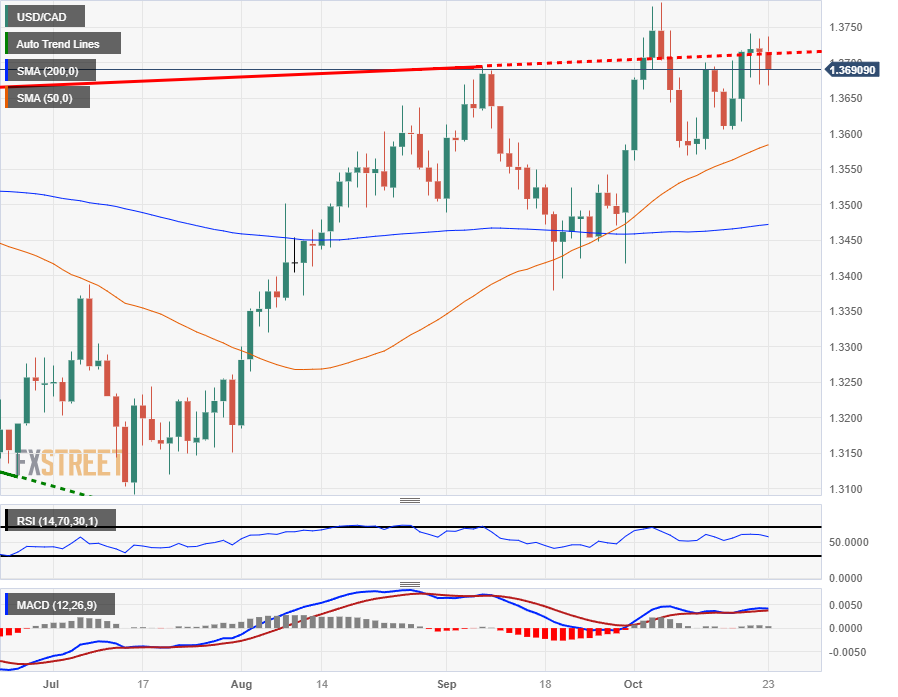Canadian Dollar holding onto Monday gains against US Dollar ahead of BoC rate call

- Canadian Dollar catching some lift as the broad-market US Dollar Index recedes.
- The Bank of Canada lands with its next rate call on Wednesday.
- Market sentiment is improving on Monday, sending the Greenback lower.
The Canadian Dollar (CAD) is finding some lift to kick off the new trading week, bolstered by investors finding their risk appetite in early trading. With the US Purchasing Manager Index (PMI), US Gross Domestic Product (GDP), and US Personal Consumption Expenditure (PCE) Index data all due in the upcoming week, the US Dollar (USD) is going to see plenty of play in the markets in the coming days.
The Bank of Canada (BoC) brings forth its latest rate call on Wednesday with a press conference to follow. The BoC holding their reference rate at 5% is a foregone conclusion, but investors will be watching for any hints of when the Canadian central bank will begin looking at rate cuts.
Daily Digest Market Movers: Canadian Dollar buoyed by US Dollar selling pressure
- The CAD is getting bolstered by broad-market pressure forcing down the USD.
- Crude Oil is also seeing declines for Monday, limiting upside potential in the oil-backed Loonie.
- US PMI figures will be released on Tuesday, overshadowing low-impact Canadian housing prices.
- Canadian New Housing Price Index is expected to show 0.1% gains in September.
- US PMI components are expected to decline slightly; Manufacturing is forecast at 49.5 (last 49.8), and Services is seen at 49.9 (last 50.1).
- The BoC’s next rate call is broadly anticipated to hold at 5%, and investors are hoping for signs that the Canadian central bank will start looking ahead to rate cuts sooner rather than later.
- Potential supply constraints stemming from the Gaza Strip conflict are easing as diplomatic efforts are underway to cool Middle East tensions, pulling back oil bids.
Technical Analysis: Canadian Dollar finds room to stretch in Monday’s mild US Dollar sell-off
The Canadian Dollar (CAD) is getting a bump up the charts as the US Dollar wanes across the broader market space, taking the USD/CAD lower on Monday and testing below 1.3700.
After Friday’s bump into its highest bids in almost two weeks, the USD/CAD is fumbling the 1.3700 handle, setting an intraday low of 1.3667 after slipping from the day’s peak at 1.3736.
Monday’s chart action has the USD/CAD set to print an inside candle to kick off the week, and traders will be keeping an eye on any breakouts from immediate chart territory. Near-term technical support sits at the 50-day Simple Moving Average (SMA), which is currently rising into 1.3600, while the ceiling sits at the last swing high into 1.3785.
USD/CAD Daily Chart
Inflation FAQs
Inflation measures the rise in the price of a representative basket of goods and services. Headline inflation is usually expressed as a percentage change on a month-on-month (MoM) and year-on-year (YoY) basis. Core inflation excludes more volatile elements such as food and fuel which can fluctuate because of geopolitical and seasonal factors. Core inflation is the figure economists focus on and is the level targeted by central banks, which are mandated to keep inflation at a manageable level, usually around 2%.
The Consumer Price Index (CPI) measures the change in prices of a basket of goods and services over a period of time. It is usually expressed as a percentage change on a month-on-month (MoM) and year-on-year (YoY) basis. Core CPI is the figure targeted by central banks as it excludes volatile food and fuel inputs. When Core CPI rises above 2% it usually results in higher interest rates and vice versa when it falls below 2%. Since higher interest rates are positive for a currency, higher inflation usually results in a stronger currency. The opposite is true when inflation falls.
Although it may seem counter-intuitive, high inflation in a country pushes up the value of its currency and vice versa for lower inflation. This is because the central bank will normally raise interest rates to combat the higher inflation, which attract more global capital inflows from investors looking for a lucrative place to park their money.
Formerly, Gold was the asset investors turned to in times of high inflation because it preserved its value, and whilst investors will often still buy Gold for its safe-haven properties in times of extreme market turmoil, this is not the case most of the time. This is because when inflation is high, central banks will put up interest rates to combat it.
Higher interest rates are negative for Gold because they increase the opportunity-cost of holding Gold vis-a-vis an interest-bearing asset or placing the money in a cash deposit account. On the flipside, lower inflation tends to be positive for Gold as it brings interest rates down, making the bright metal a more viable investment alternative.
